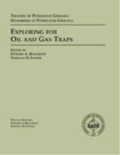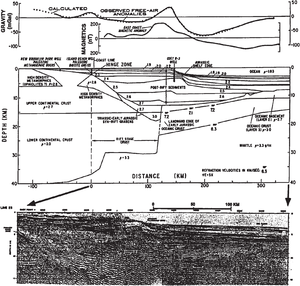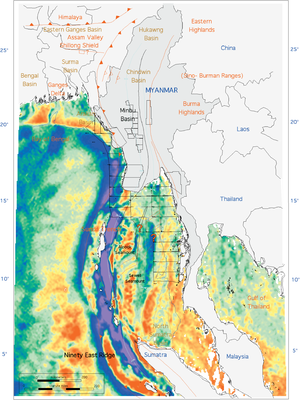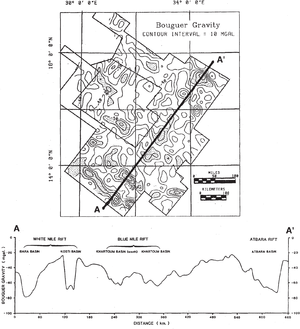Gravity applications: examples
| Exploring for Oil and Gas Traps | |

| |
| Series | Treatise in Petroleum Geology |
|---|---|
| Part | Predicting the occurrence of oil and gas traps |
| Chapter | Applying gravity in petroleum exploration |
| Author | David A. Chapin, Mark E. Ander |
| Link | Web page |
| Store | AAPG Store |
Satellite gravity, Andaman sea
Figure 1 shows a satellite-derived free air gravity color image of the Andaman Sea area of Southeast Asia. Cooler colors are gravity lows; warmer colors are gravity highs. A number of important tectonic elements can be interpreted easily from the image. The trenches are seen as deep blue, and the ridges are seen as bright red. The offshore extension of the Sumatra wrench fault system can be seen, as well as the active spreading center within the Andaman Sea (between the Alcock and Sewell seamounts). This type of data is useful for broad tectonic interpretations and to extend known geologic elements from onshore to offshore areas.
Land gravity from Sudan
In Figure 2, the upper panel shows a map of a land gravity survey taken near Khartoum, Sudan. The stippled contours are gravity values of -50 mGal and lower. The exploration objective was to identify new Mesozoic subbasins along the Central African Rift system. These subbasins cannot be seen at the surface because they are covered by a thin veneer of alluvium, sand, and river deposits. However, the subbasins, because they are lower density than cratonic basement, can be identified in the gravity data as large gravity minima, shown in the stipled pattern.

Nearby in a similar geologic setting, Chevron made a series of discoveries in the Muglad area using gravity as a primary exploration tool.[5] The gravity lows in this map indicate hitherto undiscovered subbasins, identified along gravity profile A–A′ in the bottom panel.
Marine gravity from U. S. East coast
Figure 3 shows an integrated constrained interpretation of gravity and seismic data along USGS survey line 25. Line 25 is a dip line from offshore southern New Jersey across the continental margin (over the Baltimore Canyon Trough). The free air gravity was modeled using a Talwani-type 2-D algorithm[6] and was constrained by a reflection seismic interpretation, wells, and seismic refraction data. A complex and detailed geologic cross section is the result of this study. The relationship between the synrift and postrift sediments was resolved in part by gravity modeling. In combination with the magnetic data, the type and configuration of the basement can also be resolved. Gravity interpretation had significant exploration impact in determining depth of sediment burial, migration direction, and trap development for hydrocarbon exploration within the Baltimore Canyon Trough.
See also
- Gravity basics
- Processing gravity data
- Interpreting gravity measurements
- Models of gravity anomalies
References
- ↑ Jorgensen, G. J., and W. Bosworth, 1989, Gravity modeling in the Central African Rift system, Sudan: rift geometries and tectonic significance: Journal of African Earth Sciemce, vol. 8, p. 283–306, DOI: 10.1016/S0899-5362(89)80029-6.
- ↑ Millegan, P. S., 1990, Aspects of the interpretation of Mesozoic rift basins in northern Sudan using potential fields data: Expanded abstracts with biography, SEG 60th Annual Meeting, p. 605–607.
- ↑ Grow, J. A., K. D. Klitgord, and J. S. Schlee, 1988, Structure and evolution of Baltimore Canyon Trough, in R. E. Sheridan and J. A. Grow, eds., The geology of North America, v. I-2: Geological society of America, p. 269-290.
- ↑ Sheridan, R. E., J. A. Grow, and K. D. Klitgord, 1988, Geophysical data, in R. E. Sheridan, and J. A. Grow, eds., The Geology of North America, v. I-2: Geological Society of America, p. 177–196.
- ↑ Giedt, N. R., 1990, Unity field--Sudan Muglad rift basin, Upper Nile province, in E. A. Beaumont, and N. H. Foster, eds., Structural Traps III: Tectonic Fold and Fault Traps: AAPG Treatise of Petroleum Geology Atlas of Oil and Gas Field 3, p. 177–197.
- ↑ Cady, J. W., 1980, Calculation of gravity and magnetic anomalies of finite-length right polygonal prisms: Geophysics, vol. 45, p. 1507–1512. A modified version of Talwani et. al. 1959 method of gravity modeling for a 2-D geometry. Caution: there are numerous errors in this paper. This is the method used in most current modeling programs.

